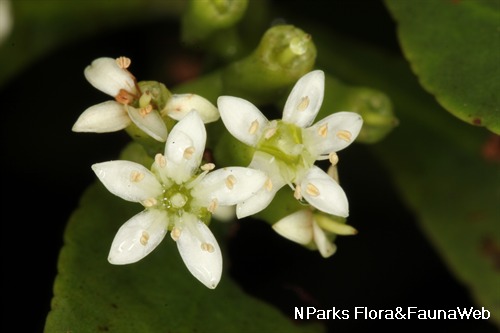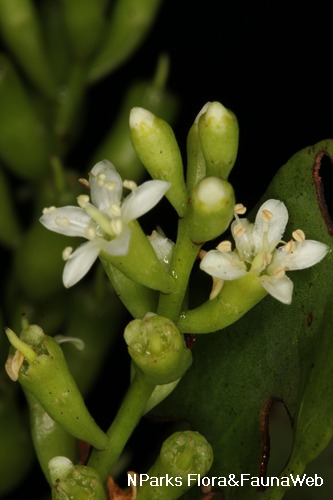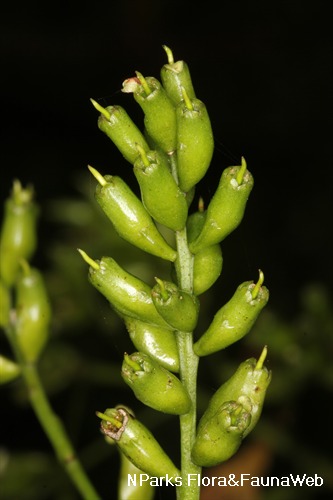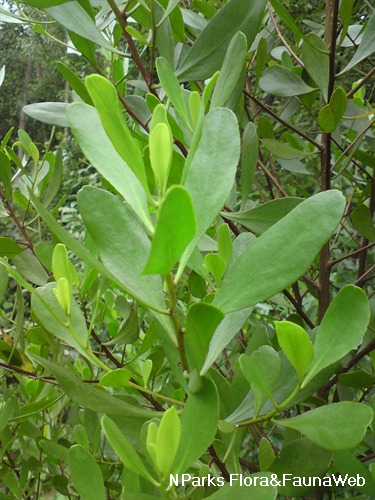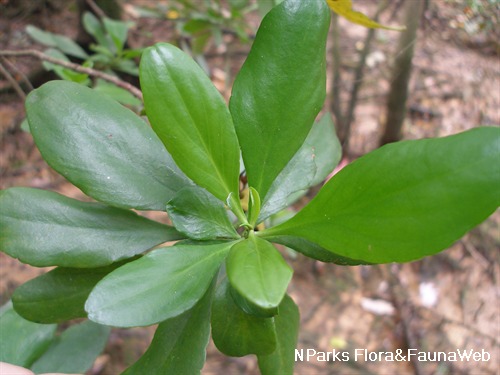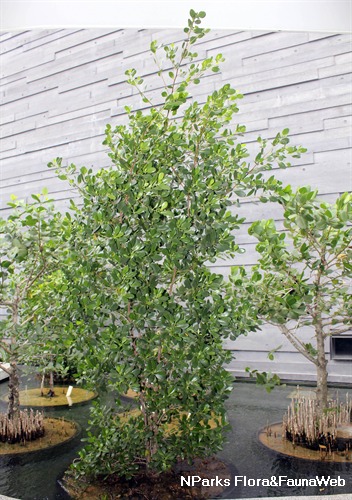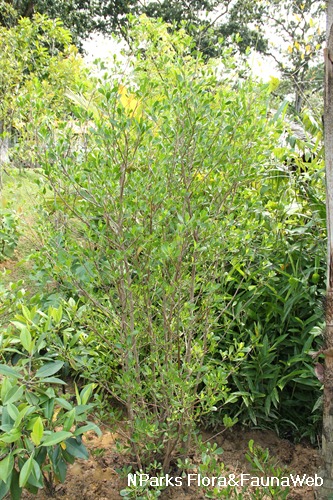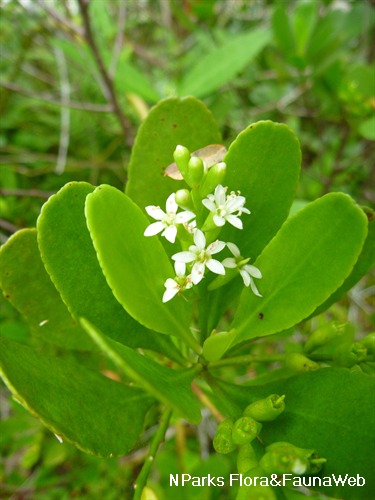
Back
Lumnitzera racemosa Willd.
| Family Name: | Combretaceae |
| Common Name: | White Teruntum, Teruntum Bunga Putih, 榄李 |
Name
Classifications and Characteristics
| Plant Division | Angiosperms (Flowering Seed Plants) (Dicotyledon) |
|---|---|
| Plant Growth Form | Tree (Small (6m-15m)), Shrub |
| Lifespan (in Singapore) | Perennial |
| Mode of Nutrition | Autotrophic |
| Plant Shape | Conical |
| Maximum Height | 8 m |
Biogeography
| Native Distribution | Eastern Africa to Southeast Asia (including Singapore), Australia, and the Pacific Islands |
|---|---|
| Native Habitat | Shoreline (Mangrove Forest, Sandy Beach, Rocky Beach) |
| Preferred Climate Zone | Tropical, Sub-Tropical / Monsoonal |
| Local Conservation Status | Native to Singapore (Endangered (EN)) |
Description and Ethnobotany
| Growth Form | It is a shrub, or tree up to 8 m tall, without the knee-shaped, upright breathing roots (pneumatophores) at its base. |
|---|---|
| Foliage | Its spirally arranged, almost stalkless leaves have fleshy leaf blades that are usually narrowly drop-shaped, and 2–9 by 1–2.5 cm, with wedge-shaped bases. |
| Flowers | Its stalkless white flowers are fragrant, and found on flowering shoots from the leaf axils. |
| Fruit | Its fruits are blackish-brown when ripe, oval or egg-shaped, slightly compressed on one side, two- or three-ridged, and 10–12 by 3–8 mm. |
| Habitat | It grows in mangrove forest, and on rocky, muddy or sandy coasts. It occurs locally in Western Catchment Nature Reserve and Pulau Ubin amongst other sites. |
| Associated Fauna | Its flowers are insect-pollinated. It is also the preferred local food plant for caterpillars of the common tit butterfly (Hypolycaena erylus teatus), and the moth Trabala vishnou. The adults of the common tit butterfly lay eggs singly on leaves, stems or young shoots of the plant. |
| Cultivation | It can be propagated by seed. |
| Etymology | Latin Lumnitzera, commemorating St. Lumnitzer (1750–1806), a Hungarian botanist; Latin racemosa, flowers growing in racemes, referring to the plant’s racemose flowering shoot consisting of a central axis with stalked flowers along it, with the youngest at the tip and the older ones progressively lower |
| Ethnobotanical Uses | Others: The plant is cultivated for its conical crown and beautiful white flowers. The bark can be used for tanning. |
Landscaping Features
| Landscaping | Its tolerance of brackish or fresh water makes the tree suitable for planting on the banks of water bodies and damp ground in public parks. |
|---|---|
| Desirable Plant Features | Ornamental Flowers, Ornamental Foliage, Ornamental Form, Fragrant |
| Landscape Uses | Parks & Gardens, Small Gardens, Coastal, Beachfront / Shoreline, Riverine, Pond / Lake / River, Marsh / Bog |
Fauna, Pollination and Dispersal
| Fauna Pollination Dispersal Associated Fauna | Butterfly Host Plant (Leaves) |
|---|---|
| Pollination Method(s) | Biotic (Fauna) |
| Seed or Spore Dispersal | Abiotic |
Plant Care and Propagation
| Light Preference | Full Sun |
|---|---|
| Water Preference | Lots of Water |
| Plant Growth Rate | Moderate |
| Rootzone Tolerance | Moist Soils, Waterlogged Soils (Drains Site, Does not Drain Site), Saline Soils / Salt Spray, Fertile Loamy Soils, Heavy Clay Soils |
| Propagation Method | Seed |
Foliar
| Foliage Retention | Evergreen |
|---|---|
| Mature Foliage Colour(s) | Green |
| Mature Foliage Texture(s) | Thick |
| Foliar Type | Simple / Unifoliate |
| Foliar Arrangement Along Stem | Alternate, Spiral |
| Foliar Attachment to Stem | Petiolate |
| Foliar Shape(s) | Non-Palm Foliage (Obovate) |
| Foliar Venation | Pinnate / Net |
Floral (Angiosperm)
| Flower & Plant Sexuality | Bisexual Flowers |
| Flower Colour(s) | White |
|---|---|
| Flower Grouping | Cluster / Inflorescence |
| Flower Location | Axillary |
| Flower Symmetry | Radial |
Fruit, Seed and Spore
| Mature Fruit Colour(s) | Brown |
|---|---|
| Fruit Classification | Simple Fruit |
| Fruit Type | Fleshy Fruit , Non-Accessory Fruit |
Image Repository
Others
| Master ID | 30102 |
|---|---|
| Species ID | 4411 |
| Flora Disclaimer | The information in this website has been compiled from reliable sources, such as reference works on medicinal plants. It is not a substitute for medical advice or treatment and NParks does not purport to provide any medical advice. Readers should always consult his/her physician before using or consuming a plant for medicinal purposes. |

